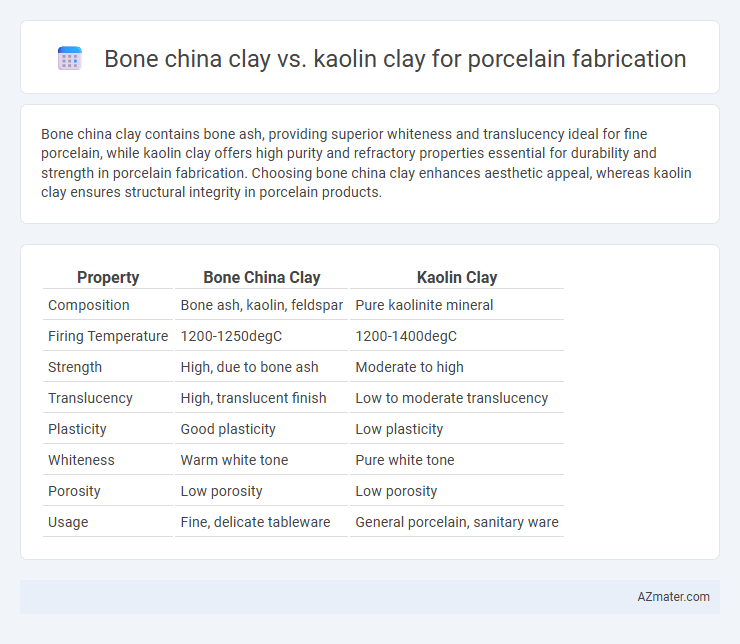Bone china clay contains bone ash, providing superior whiteness and translucency ideal for fine porcelain, while kaolin clay offers high purity and refractory properties essential for durability and strength in porcelain fabrication. Choosing bone china clay enhances aesthetic appeal, whereas kaolin clay ensures structural integrity in porcelain products.
Table of Comparison
| Property | Bone China Clay | Kaolin Clay |
|---|---|---|
| Composition | Bone ash, kaolin, feldspar | Pure kaolinite mineral |
| Firing Temperature | 1200-1250degC | 1200-1400degC |
| Strength | High, due to bone ash | Moderate to high |
| Translucency | High, translucent finish | Low to moderate translucency |
| Plasticity | Good plasticity | Low plasticity |
| Whiteness | Warm white tone | Pure white tone |
| Porosity | Low porosity | Low porosity |
| Usage | Fine, delicate tableware | General porcelain, sanitary ware |
Introduction to Bone China Clay and Kaolin Clay
Bone china clay, composed primarily of bone ash, feldspar, and kaolin, is prized for its whiteness, translucency, and high mechanical strength in porcelain fabrication. Kaolin clay, a key ingredient derived from weathered feldspar-rich rocks, provides essential plasticity and whiteness but lacks the translucency and durability that bone ash imparts. In porcelain production, blending bone china clay with kaolin clay enhances the thermal stability, hardness, and aesthetic qualities of the final ceramic product.
Composition and Mineral Content Comparison
Bone china clay contains a significant proportion of bone ash (typically 25-45%), along with kaolin and feldspar, which imparts high whiteness, translucency, and strength to porcelain. Kaolin clay, primarily composed of the mineral kaolinite (Al2Si2O5(OH)4), serves as the essential aluminosilicate base in porcelain fabrication but lacks the bone ash component, resulting in lower translucency and different firing characteristics. The mineral content distinction, with bone china's calcium phosphate from bone ash versus kaolin's pure kaolinite structure, directly influences porcelain's mechanical properties and aesthetic qualities.
Physical Properties: Strength, Whiteness, and Translucency
Bone china clay exhibits superior strength due to the incorporation of bone ash, resulting in higher mechanical durability compared to kaolin clay, which is primarily composed of pure hydrated aluminum silicate. In terms of whiteness, kaolin clay provides a naturally bright white base, whereas bone china clay achieves a slightly warmer tone influenced by the bone content. Translucency in bone china clay is markedly enhanced, offering a delicate and semi-transparent finish, while kaolin-based porcelain tends to be more opaque and less light-permeable.
Workability and Molding Characteristics
Bone china clay exhibits superior workability due to its fine particle size and higher plasticity, making it easier to shape intricate designs in porcelain fabrication. Kaolin clay, while essential for its high refractory properties, has a coarser texture and lower plasticity, which can limit molding flexibility and require blending with other clays to improve workability. The combination of bone ash and kaolin in bone china allows for enhanced strength and translucency while maintaining excellent molding characteristics crucial in high-quality porcelain production.
Firing Temperatures and Thermal Behavior
Bone china clay typically fires at lower temperatures, around 1200-1250degC, exhibiting superior translucency and higher strength due to the presence of bone ash enhancing vitrification. Kaolin clay, used in traditional porcelain production, requires higher firing temperatures, approximately 1300-1400degC, to achieve full vitrification and rigidity, resulting in a denser and more opaque body. Thermal behavior differences stem from the calcium phosphate in bone ash facilitating fluxing action, lowering melting points, whereas pure kaolin displays higher thermal stability and less shrinkage during firing.
Porosity and Final Product Quality
Bone china clay exhibits lower porosity compared to kaolin clay, resulting in denser and more translucent porcelain products. Kaolin clay, while purer and less expensive, produces porcelain with higher porosity, which can affect strength and translucency negatively. The superior vitrification of bone china clay enhances the final product's durability, whiteness, and smooth texture, making it ideal for high-quality porcelain fabrication.
Common Applications in Porcelain Fabrication
Bone china clay is prized for its high whiteness, translucency, and strength, making it ideal for fine tableware, decorative items, and luxury porcelain pieces. Kaolin clay, a key component in porcelain fabrication, provides plasticity and durability, commonly used in making ceramic tiles, sanitary ware, and traditional white porcelain. Combining bone china clay with kaolin enhances workability and firing properties, essential for high-quality porcelain production.
Cost and Sourcing Considerations
Bone china clay contains bone ash, increasing raw material costs and limiting sourcing to regions with abundant animal bone supply, whereas kaolin clay, derived from weathered feldspar, is more widely available and generally less expensive. The higher purity and strength of kaolin reduce processing costs in porcelain fabrication, but bone china's unique translucency and whiteness often justify its premium price in luxury markets. Manufacturers balance cost efficiency with desired aesthetic qualities by selecting kaolin for economical mass production and bone china for high-end porcelain products.
Environmental Impact and Sustainability
Bone china clay, predominantly composed of bone ash, kaolin, and feldspar, requires the sourcing of animal bone, raising concerns about ethical and environmental sustainability due to livestock farming emissions. Kaolin clay, a natural mineral extracted from the earth, involves mining processes that can lead to habitat disruption and soil erosion but generally results in a lower carbon footprint compared to bone-derived materials. Sustainable porcelain fabrication trends favor kaolin clay due to its mineral origin and potential for recycling, whereas bone china production's reliance on animal by-products presents challenges for eco-friendly manufacturing.
Choosing the Right Clay for Your Porcelain Project
Bone china clay contains bone ash, giving it superior whiteness, translucency, and strength, making it ideal for delicate, high-quality porcelain projects. Kaolin clay, a pure white clay rich in alumina and silica, offers excellent plasticity and firing stability, preferred for traditional porcelain fabrication. Choosing between bone china and kaolin depends on the desired finish, translucency, and durability of the porcelain piece.

Infographic: Bone china clay vs Kaolin clay for Porcelain fabrication
 azmater.com
azmater.com